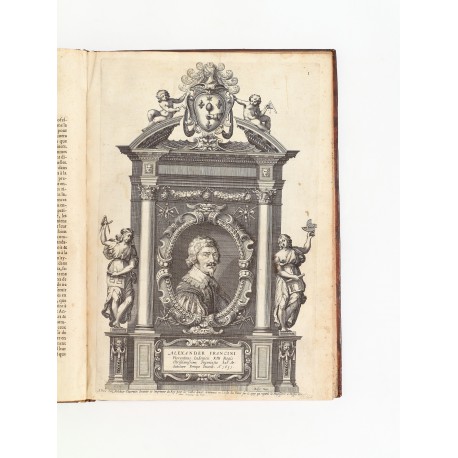Livre d’architecture contenant plusieurs portiques de differentes inventions, sur les cinq ordres de colomnes
- Subjects
- Architectural books - Early works to 1800
- Architecture, French - Early works to 1800
- Art books - Early works to 1800
- Book illustration - Artists, French - Bosse (Abraham), 1602-1676
- Book illustration - Artists, French - Tavernier (Melchior), c. 1564-1641
- Book illustration - Pattern books - Early works to 1800
- Authors/Creators
- Francini, Alessandro, after 1571-1648
- Artists/Illustrators
- Bosse, Abraham, 1602-1676
- Francini, Alessandro, after 1571-1648
- Tavernier, Melchior, c. 1564-1641
- Printers/Publishers
- Tavernier, Melchior, active 1613-1641
Francini, Alessandro
Florence? after 1571 – 1648 Fontainebleau?
Livre d’architecture contenant plusieurs portiques de differentes inventions, sur les cinq ordres de colomnes.
Paris, Melchior Tavernier, 1631
folio (387 × 275 mm), (4) ff. letterpress (title, descriptive list of plates, author’s dedication to Henri iv, address ‘Aux Amateurs d’Architecture’), plus forty numbered engraved plates (circa 360 × 250 mm, platemarks).
provenance early inscription on title-page obliterated — E.P. Goldschmidt & Co. Ltd., ‘Catalogue 167: Rare books xv to xviii centuries’, London 1987, item 64 — Private collection, Dublin
A few insignificant stains, on the whole, an excellent copy.
binding contemporary French mottled calf.
Engraving by Melchior Tavernier (platemark 355 × 250 mm)
First issue of a series of forty designs for monumental doorways and entrances in a Mannerist style, by a Florentine who had been invited to the French court about 1598 to create grottoes and fountains in the grounds of Saint-Germain-en-Laye and later in Marie de Médicis’ garden of the Luxembourg. Of all the Orders, Alessandro Francini found the massive Doric most suited to these kinds of monuments, and he uses its form and proportions in nineteen designs, while six designs develop the Tuscan column, six the Ionic, five the Corinthian, and three feature the Composite Order.
Thirty-one plates are inscribed A. Francini Inventor | Tavernier excudit and six merely A. Francini inventor. In the present copy and most others, the portrait of Francini (plate no. 1, described in list of plates as ‘laquelle peut seruir à vn Avtel’) is signed Bosse fecit above Tavernier’s imprint, and plates 2 and 4 are inscribed respectively Melchior Tavernier fecit and Melchior Tavernier sculpsit. Some cataloguers suppose that the unsigned plates are by Abraham Bosse;1 others consider them the work of Tavernier and his atelier.2
A second edition employing the same plates was published in 16403 and an English version (illustrated by reversed copies) was published at London by Robert Pricke in 1669.4
references Désiré Guilmard, Les Maîtres Ornemanistes (Paris 1880), pp.311–312; Katalog der Ornamentstichsammlung der Staatlichen Kunstbibliothek Berlin (1939), no. 3852; Laurence Hall Fowler and Elizabeth Baer, The Fowler Architectural Collection of Johns Hopkins University. Catalogue (Baltimore 1961), no. 126; Theodore Besterman, Old art books (London 1975), p.42; Architectural theory and practice from Alberti to Ledoux, catalogue of an exhibition, edited by Dora Wiebenson (Chicago & London 1982), no. III–A/12; Avery’s choice: Five centuries of great architectural books, edited by Adolf Placzek (New York 1997), p.58 no. 76; Yves Pauwels, ‘Francine, Collot, Barbet: recueils de modèles ou exercices de style?’ in Le livre et l’architecte: actes du colloque organisé par l’Institut national d’histoire de l’art et l’École nationale supérieure d’architecture de Paris-Belleville, Paris, 31 janvier–2 février 2008, edited by Jean-Philippe Garric, Émilie d’Orgeix and Estelle Thibault (Wavre 2011), pp.167–171
1. Georges Duplessis, Catalogue de l’œuvre de Abraham Bosse (Paris 1859), nos. 298–337; Abraham Bosse, savant graveur 1604–1676, catalogue by Sophie Join-Lambert and Maxime Préaud of an exhibition held in the Bibliothèque nationale de France (Paris 2004), nos. 62 (frontispiece), 63 (pl. 17).
2. Roger-Armand Weigert, ‘Le commerce de la gravure en France au xviieme siècle: les Tavernier’ in De Gulden Passer 53 (1975), p.429.
3. Avenir Tchemerzine, Répertoire de livres à figures… édités en France au xviie siècle (Paris 1933), pp.187–189; National Gallery of Art, The Mark J. Millard Architectural Collection, i: French books (Washington, dc 1993), no. 75.
4. Eileen Harris, British architectural books and writers (Cambridge 1990), p.196 no. 229. The copyist modified the prints, deleting the insignia of France and Navarre, and reversing their direction; cf. the essay by Jean-Marie Pérouse de Montclos, on the CESR database ‘Architectura / Les livres d’architecture’ (link).






